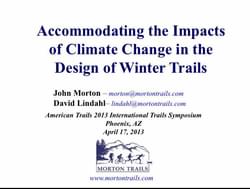




This presentation will review fundamental trail design considerations for skiing and winter trails.

Speaker: John Morton, Principal and Founder, Morton Trails
Cross country skiing includes an estimated 10.2 million participants, up from 3.5 million in 2007, making it one of the fastest growing trail-based activities. Other winter activities, such as snowshoeing and winter mountain biking, have also become popular in areas with reliable snow. As these activities become more popular, traditional locations have less predictable snowfall, emphasizing a need to re-think the planning, design, and management of Nordic skiing and winter-based trail systems. Based on examples from across the United States and internationally, this presentation will review fundamental trail design considerations for skiing and winter trails, with new techniques and approaches to address issues of warmer winters and less snowfall. These approaches include considerations of site location, trail width, surface, gradient and slope aspect (orientation), grooming equipment, snowmaking, and alternative surfaces. Additionally, the presentation will provide management approaches to diversify and provide financially stable trail-based winter activities, including both opportunities for competition and events as well as recreation, along with four-season use of trails.
1,408 views • posted 02/19/2018